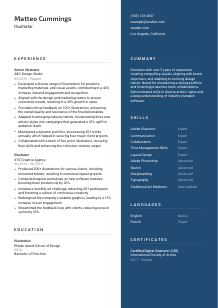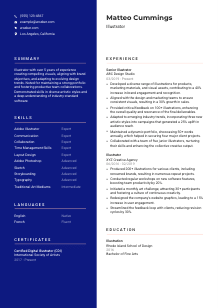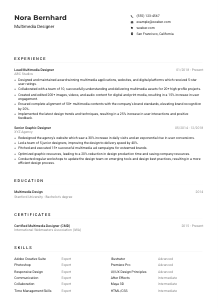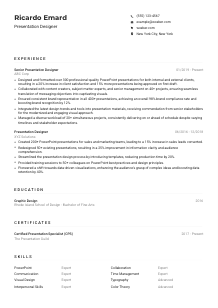Illustrator Resume Example
Bringing visuals to life, but your resume seems a bit sketchy? Check out this Illustrator resume example, fine-tuned with Wozber free resume builder. Discover how effortlessly you can illustrate your creative prowess to meet job specifics, crafting a career narrative as vibrant as your portfolio!

How to write an Illustrator Resume?
Welcome, creative visionary! Navigating the world of job hunting as an Illustrator requires more than a keen eye for design—it demands a resume that not only showcases your artistic prowess but also speaks the language of Applicant Tracking Systems (ATS). Fear not! With the help of Wozber's free resume builder, including its ATS-friendly resume template and ATS resume scanner, you're about to embark on an adventure to mold your resume into a masterpiece that not only captures the essence of your creativity but also sails smoothly through the ATS.
Ready to draw your path to success? Let's dive into the vibrant world of resume crafting tailored for the Illustrator profession.
Personal Details
Begin your journey with the Personal Details section, more than just a formality, it's the window through which potential employers get their first glimpse of you. Let's infuse some creativity into crafting this section, making sure it harmonizes with the Illustrator role.
1. Set the Canvas
Your name is more than a label—it's the title of your professional portfolio. Make it pop! Consider a font that's readable yet reflects your personal brand. You're an Illustrator, after all. Let your creativity shine from the very top of your resume.
2. Align with Your Artistic Title
"Illustrator" isn't just a job title; it's an identity. Position it boldly beneath your name, resonating instantly with the job you're aiming for. This subtle alignment immediately tells the hiring manager, "Yes, I belong here."
3. Brush Strokes of Contact
In the world of email addresses, be a masterpiece—not a draft. An email that reads firstname.lastname@email.com speaks volumes of your professionalism. And remember, your phone number is the direct line to your next big break. Double-check for clarity and accuracy.
4. Location, Location, Location
Given the job's call for a Los Angeles-based Illustrator, pinpointing "Los Angeles, California" in your resume isn't just about geography—it's about proving you're in the right place at the right time. No relocation necessary means one less hurdle in your job journey.
5. Your Portfolio: The Exhibit
If ever there was a place to showcase your digital portfolio, it's here. Your website or portfolio link is your gallery—invite them in. Select works that resonate most with the job specifications. This is your virtual handshake; make it memorable.
Takeaway
Your Personal Details section is your resume's opening exhibit. It introduces you, not just as a professional but as an Illustrator ready to make their mark. Crafted thoughtfully, it sets the stage for the story you're about to unveil. Onward to the next gallery of your resume!





Experience
The Experience section: where your journey as an Illustrator takes center stage. Here, you'll weave your professional tale, illustrating how each role you've played has added strokes of skill and color to your canvas. Let's ensure it's a narrative that captivates.
- Developed a diverse range of illustrations for products, marketing materials, and visual assets, contributing to a 40% increase in brand engagement and recognition.
- Aligned with the design and marketing teams to ensure consistent visuals, resulting in a 30% growth in sales.
- Provided critical feedback on 100+ illustrations, enhancing the overall quality and resonance of the final deliverables.
- Adapted to emerging industry trends, incorporating three new artistic styles into campaigns that generated a 25% uplift in audience reach.
- Maintained a dynamic portfolio, showcasing 50+ works annually, which helped in securing four major client projects.
- Collaborated with a team of five junior illustrators, nurturing their skills and enhancing the collective creative output.
- Produced 200+ illustrations for various clients, including renowned brands, resulting in numerous repeat projects.
- Conducted regular workshops on new software features, boosting team productivity by 20%.
- Initiated a monthly art challenge, attracting 30+ participants and fostering a culture of continuous creativity.
- Redesigned the company's website graphics, leading to a 15% increase in user engagement.
- Streamlined the feedback loop with clients, reducing revision cycles by 30%.
1. Analyze the Palette
Start with the job description's requirements. Highlight keywords related to responsibilities and skills. For instance, "Create and develop illustrations for products" demands examples of tangible project outcomes. This is your guideline for what to highlight in your stories of experience.
2. Layer Your Roles
Organize your experience like a series of your finest works, starting with the most recent. Include your role title, the name of the company, and the timeframe. This structure helps hiring managers visualize your career progression and artistic evolution.
3. Illustrate Your Impact
Each role you list should be accompanied by bullet points that highlight how you've made a difference. Did your illustrations increase brand engagement? Say so, and whenever possible, back it up with percentages or other measures. This quantification brings your impact to life.
4. Selectivity Is Your Friend
Not all your achievements need to make it to this exhibition. Choose those that align best with the role you're applying for. Your time teaching art, for example, might not be as relevant. Focus on what underscores your fit for the Illustrator position.
5. Speak Their Language
Adopt keywords from the job description in your descriptions. For instance, if they seek someone adept in "Adobe Illustrator and Photoshop," ensure those exact phrases find their way into your experience narratives. This is part of optimizing your resume for ATS.
Takeaway
Your Experience section is your portfolio within your resume. Each entry is a testament to your craftsmanship. By meticulously aligning it with the job's demands and speaking the ATS language, you not only prove your qualifications; you showcase your readiness to contribute to the next chapter in your career. With your achievements vividly illustrated, the stage is now set for your educational background to shine.
Education
In the story of your professional journey, your education is the foundation on which you've built your skills. It's more than a degree; it's a reflection of your dedication to your craft. Let's sculpt your Education section to highlight its relevance to your Illustrator aspirations.
1. Highlight the Cornerstone
Start by echoing the job description. If it calls for a "Bachelor's degree in Illustration, Fine Arts, or a related field," make sure your highest relevant qualification leads the way. This direct match is your first, powerful signal of alignment.
2. The Structure of Your Story
Maintain clarity with a straightforward structure: Degree, Field of Study, Institution, and Graduation Date. This clean presentation allows the hiring manager to quickly assess your educational credentials without having to search or interpret.
3. Tailor to the Theme
If your degree directly matches the job's field, make it known. For example, a "Bachelor of Fine Arts in Illustration" speaks volumes. It says you're not just in the field; you were trained specifically for this kind of creative endeavor.
4. Exhibit Relevant Gems
Though not always necessary, if you're early in your career, shine a light on specific coursework or projects relevant to the Illustrator role. Did you excel in digital illustration or a particular software? This detail can add depth to your qualifications.
5. Further Education Flair
Beyond your degree, if you've undertaken additional certifications or workshops that enhance your credentials as an Illustrator, let them feature here, especially if they're recognized within the industry. This shows continuous learning—a trait highly valued in creative fields.
Takeaway
Your Education section does more than list degrees; it underscores your journey into the world of illustration. It's crafted to convince hiring managers of your firm foundation in the field, setting the stage for additional qualifications you've gathered along the way, like certifications and skills.
Certificates
In an evolving field like illustration, staying updated through certifications is a testament to your dedication and passion. Let's curate your Certificates section to highlight those achievements that elevate your expertise and align with the Illustrator role.
1. Selective Showcase
Even though the job description may not explicitly request certifications, including relevant ones, like a "Certified Digital Illustrator (CDI)," showcases your ongoing commitment to excellence and professional development.
2. Quality over Quantity
Rather than listing every certificate you'veever achieved, prioritize those that strengthen your candidacy for this specific Illustrator role. Focus on what makes you stand out and what directly relates to the skills and software mentioned in the job description.
3. Dated Credentials
For certificates with expiration dates or those that were earned recently, include these dates. This element offers insight into your current knowledge level, especially for skills prone to rapid evolution, such as software proficiencies.
4. Continuous Learning
The field of illustration is dynamic, with new techniques and tools emerging regularly. Emphasize your dedication to keeping up-to-date by participating in industry-relevant courses and workshops. This eagerness to learn is a trait that can set you apart in the selection process.
Takeaway
Your Certificates section is a gallery of your dedication to growth and skill enhancement. It's not just about the certifications you've collected; it represents your commitment to evolving as an Illustrator. With your certificates strategically curated, let's turn the page to the diverse palette of skills you bring to the table.
Skills
The Skills section of your resume is where you get to showcase the tools in your artistic arsenal. It's a concise list, but each item should paint a picture of your abilities and how they align with what the job is asking for. Let's make sure it's a compelling piece of your career canvas.
1. Brush Up On Requirements
First, decode the job listing to highlight indispensable skills. Proficiency in "Adobe Illustrator and Photoshop," for example, is non-negotiable. Matching these explicitly showcases your candidacy's relevance and your understanding of the role's core needs.
2. A Balanced Palette
Combine hard skills, like software proficiencies, with soft skills, such as communication and time management, that the job description emphasizes. This mix illustrates your versatility, making you a well-rounded candidate beyond just technical abilities.
3. Order and Precision
Prioritize your skills list starting with those most relevant to the job. An ATS, and ultimately the hiring manager, will first notice these. Each skill listed is a brush stroke contributing to the overall impression you make. Choose wisely and ensure clarity and relevance.
Takeaway
Your Skills section might be brief, but it's mighty. It's your opportunity to highlight how every tool and trait in your portfolio aligns with what the role demands. By artfully selecting and positioning your skills, you convey not just your qualifications but your strategic understanding of the role. Now, let's navigate the language palette to further enrich your global appeal.
Languages
In the global marketplace, the ability to communicate across cultures is a unique asset, especially in creative fields that transcend borders. Your proficiency in languages can add depth to your professional profile. Match your linguistic skills to the needs of the Illustrator role, and let's explore how.
1. Core Communication
With "Effective English communication skills are a must," as stated in the job description, ensure your proficiency level in English is clearly mentioned. This non-negotiable skill secures your ability to engage with the team and clients effectively.
2. Additional Accents
Beyond the essentials, list other languages you're fluent in. Each additional language is a testament to your ability to operate in a diverse work environment, making you a valuable asset for collaborations that may reach beyond local boundaries.
3. Clear Proficiency Levels
Be specific about your language levels. Using terms like "Native," "Fluent," "Intermediate," and "Basic" gives hiring managers a clear understanding of your communication capabilities in each language.
4. The Bigger Picture
While not directly related to the act of illustrating, your linguistic skills reflect your ability to navigate and contribute to a multicultural workplace, enhancing collaboration and creativity. It's a soft skill that complements your technical prowess.
5. Continuous Dialogue
Remember, language skills are dynamic. Regular use and study can lead to improvements, opening new doors and opportunities. Reflect any progress in your resume to keep it current and reflective of your evolving capabilities.
Takeaway
Your proficiency in languages paints you as a versatile and adaptable professional, poised to engage in the diverse dialogues of the creative world. It's a unique color on your palette, enhancing your appeal in the eyes of potential employers. With your linguistic skills well-articulated, let's finetune the crowning jewel of your resume—the Summary.
Summary
The Summary is your resume's headline act, a brief yet bold statement where you encapsulate your essence as an Illustrator. It's not just about what you've done; it's a vivid brushstroke that paints who you are and what you aspire to bring to your next role. Captivatingly distill your narrative here.
1. The Essence of Your Story
Begin by absorbing the essence of the job and translating it into a narrative that resonates with your own journey. Highlight your years of experience, areas of expertise, and the unique flair you bring to your work. This is your chance to shine in the spotlight.
2. Your Signature Skills
Weave into your summary the skills and achievements that are most aligned with the job description. Did your illustrations lead to a significant increase in brand recognition? Incorporate this achievement to demonstrate the tangible value you can bring.
3. A Masterpiece in Brevity
While it might be tempting to detail every accolade, the art of the summary lies in its conciseness. Aim for 3-5 lines that confidently communicate your identity as an Illustrator, sparking intrigue and leaving the audience wanting more.
4. The Prelude to More
Think of your summary as the prelude to the detailed narrative that unfolds in your resume. It sets the tone and invites the hiring manager to dive deeper into the chapters of your professional story, eager to uncover the full spectrum of your creativity and skills.
Takeaway
Crafted with care, your Summary is the gateway to your resume, offering a glimpse into your world as an Illustrator. It's a pitch that's as intriguing as it is informative, compelling hiring managers to explore further. With your resume now finely tuned across every section, you're ready to embark on your job quest with confidence. Remember, Wozber is here to guide you with a free resume builder, ATS-friendly resume templates, and an ATS resume scanner, empowering you to create a resume that not only meets but exceeds job requirements. Your next great opportunity awaits—go forth and create your future!
Launching Your Illustrator Journey
Congratulations! You've navigated through the essential chapters of crafting an Illustrator resume with finesse and creativity. With this tailored guide and the support of Wozber's free resume builder, including its innovative ATS resume scanner, you're not just submitting a resume; you're presenting a portfolio that narrates your unique story through the prism of professional excellence. Remember, your resume is a dynamic canvas—continually refine it as your career evolves. The world of creativity is vast, offering endless opportunities to those who dare to dream and design their destiny.
Your journey is just beginning, and each stroke of effort brings you closer to your masterpiece. Embrace your talent, trust the process, and let your career as an Illustrator flourish. The stage is set, the spotlight is yours—paint your path to success!

- Bachelor's degree in Illustration, Fine Arts, or a related field.
- Minimum of 3 years of professional experience in illustration or a related field.
- Proficiency in industry-standard software such as Adobe Illustrator, Adobe Photoshop, and Sketch.
- Strong understanding of various artistic styles and techniques, with the ability to adapt as necessary.
- Excellent communication, collaboration, and time management skills.
- Effective English communication skills are a must.
- Must be located in Los Angeles, California.
- Create and develop illustrations for products, marketing materials, and other visual assets.
- Collaborate with the design and marketing teams to ensure visuals align with brand guidelines and objectives.
- Review and provide feedback on illustrations produced by other team members.
- Stay updated on industry trends and incorporate emerging styles and techniques into work.
- Maintain a portfolio of work and be prepared to present and discuss illustrations with clients and stakeholders.















